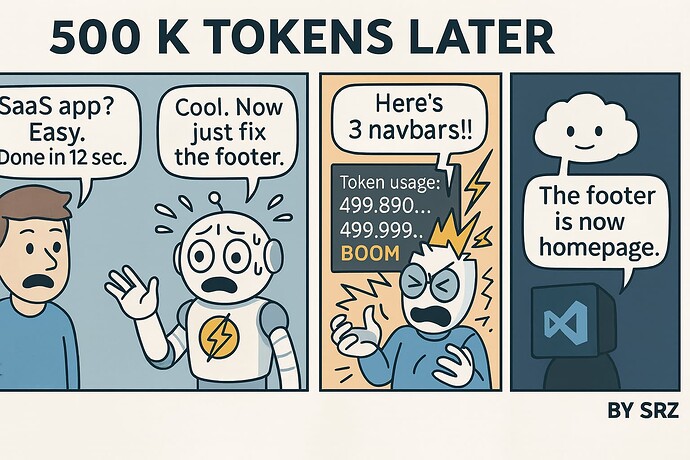 A Quick Intro: Bolt’s Speed Comes at a Price
A Quick Intro: Bolt’s Speed Comes at a Price
Bolt.new promises to build full-stack apps from simple prompts. It looks slick, feels fast, and works great—until it doesn’t. Users love it until they hit that point where Bolt stops helping and starts breaking things it already built. This guide walks through exactly what goes wrong, how to fix it, and how to finish your app without screaming into the void.
![]() One-Line Reality Check:
One-Line Reality Check:
Bolt builds the first 70% like magic—then stalls, rewrites your code, eats your tokens, and dares you to finish manually unless you follow this escape plan.
 Why Bolt.new Falls Apart
Why Bolt.new Falls Apart
- Bolt forgets your earlier instructions mid-way.
- It rewrites files you already fixed.
- “Diff mode” is supposed to help—but often causes more problems than it solves.
- It crashes or locks up once token usage crosses ~500,000.
- Cost goes wild if you keep pushing—up to 10M tokens used in a few days by some users.
- You can’t finish a full app without splitting it, restarting, or switching tools.
 A Real Fix That Actually Works
A Real Fix That Actually Works
1. Build the First 70% on Bolt.new
Start simple. Don’t enable experimental features like Diff Mode until you’re sure the project is stable.
Use:
![]() https://bolt.new
https://bolt.new
2. Clean Up Before You Make Changes
Open the terminal in Bolt and run:
npx knip --production --fix --allow-remove-files
This removes unused code and helps prevent Bolt from choking on too many files.
Then create a .bolt/ignore file and include:
docs/
assets/
tests/
migrations/
This hides extra junk from the AI so it doesn’t waste tokens or break stuff it shouldn’t even see.
3. Split the Project Before It Gets Big
Don’t wait until your app breaks. Create separate Bolt projects early:
- Login system
- Payment or Stripe flow
- Dashboard layout
- API/backend logic
Build each part in its own Bolt instance. It’s like working with smaller LEGO blocks instead of forcing everything into one massive tower that collapses halfway through.
4. When Bolt Starts Glitching, Move to Bolt.diy
Bolt.diy is the self-hosted version. It gives you more control, and you’re not charged per token like on Bolt.new.
![]() https://github.com/stackblitz/bolt
https://github.com/stackblitz/bolt
5. Add Gemini Flash to Bolt.diy for Free AI Power
You can connect Google Gemini 2.0 Flash to Bolt.diy. It’s fast, light, and free (within rate limits).
Set up Gemini Flash here:
![]() https://console.cloud.google.com
https://console.cloud.google.com
Important:
- Gemini Flash handles large inputs
- It returns fewer output tokens (~8K), so give it smaller tasks
- It’s perfect for finishing what Bolt started
6. Finish Strong in VS Code
Once Bolt gets you 80% of the way, switch to VS Code.
Use these tools to clean and finish:
These let you write or fix code with smart suggestions—without dealing with Bolt’s memory issues or rewrite loops.
 Known Problems and Fixes
Known Problems and Fixes
Problem: Bolt rewrites your fixed files
Fix: Turn off Diff mode and reduce context with .bolt/ignore
Problem: Project crashes or stops loading
Fix: Duplicate your Bolt project and include a summary prompt to reset memory
Problem: “Prompt too long” errors
Fix: Keep project under 500,000 tokens OR fork to Bolt.diy + Gemini Flash
Problem: Costs too much
Fix: Self-host Bolt.diy and use free Gemini Flash API
 Tools and Links Recap
Tools and Links Recap
 Bolt.new: https://bolt.new
Bolt.new: https://bolt.new Bolt.diy GitHub: https://github.com/stackblitz/bolt
Bolt.diy GitHub: https://github.com/stackblitz/bolt Google Gemini Flash (Free): https://console.cloud.google.com
Google Gemini Flash (Free): https://console.cloud.google.com Knip (Cleanup Tool): https://github.com/webpro/knip
Knip (Cleanup Tool): https://github.com/webpro/knip Roo for VS Code: https://marketplace.visualstudio.com/items?itemName=roocode.roo
Roo for VS Code: https://marketplace.visualstudio.com/items?itemName=roocode.roo GitHub Copilot: https://github.com/features/copilot
GitHub Copilot: https://github.com/features/copilot
 Final Advice
Final Advice
Build fast with Bolt.new.
Split and clean before it crashes.
Fork to Bolt.diy when things go bad.
Plug in Gemini Flash to keep going.
Finish strong in VS Code like a real dev.
 Sui…simple!
Sui…simple!
Bolt builds fast. It just forgets who it is halfway through—good thing you don’t.

 !
!